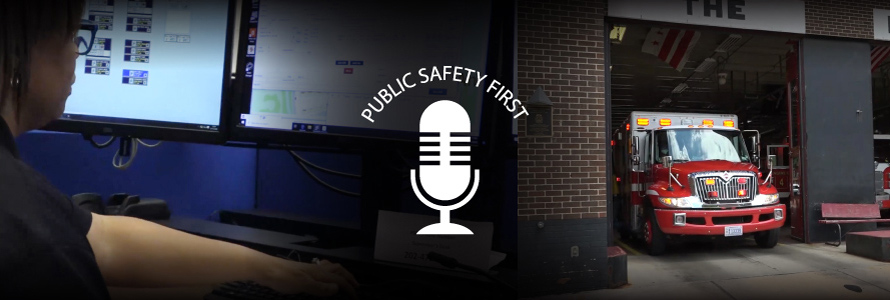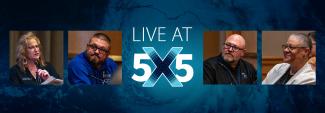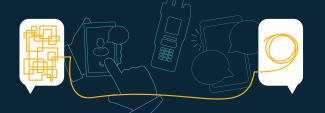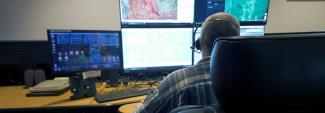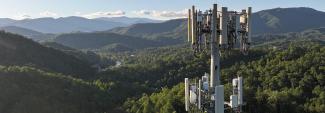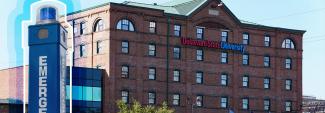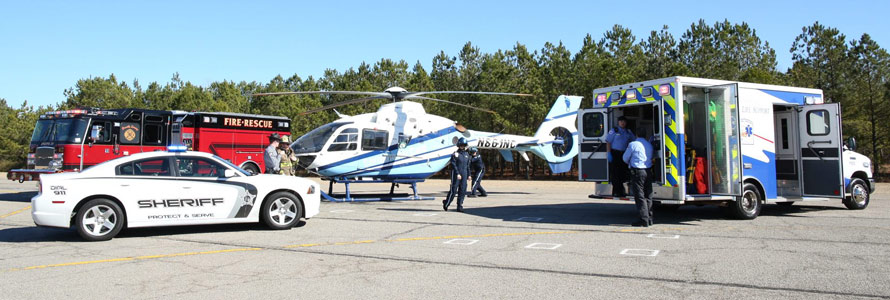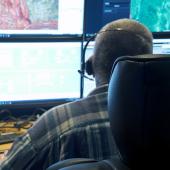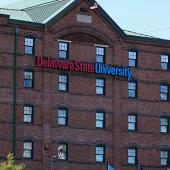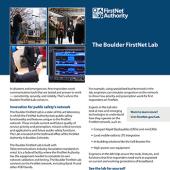Summary
The Office of Unified Communications (OUC) in Washington D.C. is responsible for 9-1-1 and 3-1-1 calls in the nation’s capital, as well as dispatch services and radio communications for D.C. first responders. The OUC handles nearly 3.5 million emergency and non-emergency calls each year. When the pandemic hit, the OUC turned to FirstNet MiFis to support remote telework for 3-1-1 and non-emergency 9-1-1 call takers, keeping staff safe while answering the call for D.C. residents and visitors.
Guest
Lori Stone
FirstNet Authority Senior Public Safety Advisor
Teddy Kavaleri
Chief IT Officer, District of Columbia Office of Unified Communications
Transcript
Preview
Narrator: You're listening to Public Safety First, a podcast to help you learn about the First Responder Network Authority and how you can be part of the future of public safety technology.
And now, your host.
Lori Stone: Welcome to the Public Safety First podcast. I’m Lori Stone, and I serve as the Senior Public Safety Advisor for the Mid-Atlantic with the First Responder Network Authority, and I’m joined today by Teddy Kavaleri. He’s the Chief IT Officer for the District of Columbia’s (the District) Office of Unified Communications. OUC, as it’s called, provides centralized district-wide coordination and management of public safety voice radio technology. OUC has been on FirstNet for about a little over a year, and we’re really pleased that Teddy could join us today. Welcome to the podcast, Teddy.
Narrator: You're listening to Public Safety First, a podcast to help you learn about the First Responder Network Authority and how you can be part of the future of public safety technology.
And now, your host.
Lori Stone: Welcome to the Public Safety First podcast. I’m Lori Stone, and I serve as the Senior Public Safety Advisor for the Mid-Atlantic with the First Responder Network Authority, and I’m joined today by Teddy Kavaleri. He’s the Chief IT Officer for the District of Columbia’s (the District) Office of Unified Communications. OUC, as it’s called, provides centralized district-wide coordination and management of public safety voice radio technology. OUC has been on FirstNet for about a little over a year, and we’re really pleased that Teddy could join us today. Welcome to the podcast, Teddy.
Teddy Kavaleri: Thanks for having me.
Lori Stone: Let’s start with learning a little bit more about you and your background. Tell us how you got involved in public safety communications.
Teddy Kavaleri: I’ve been working with OUC and the District a little over 15 years now. I came in as a wireless consultant to support a public safety radio system upgrade back in the early 2000s. I was part of a large engineering team, helping build a ten-site, city-wide system that combined police, fire, and EMS and about 20 other District agencies that were using the radio system in the District.
Lori Stone: So, you’ve seen OUC grow in size and scope over the years. Can you tell me more about OUC and its operations?
Teddy Kavaleri: Yes. So, the Office of Unified Communications – that’s the name – is a true unified communications agency. We not only handle 9-1-1 emergency/non-emergency calls, but we also handle 3-1-1 city service calls. Our agency also provides public safety communications support for the police department, fire and EMS, homeland security, emergency management, and about 20 other District agencies. We also support interoperable communications with regional federal partners, and jurisdictions that work across the borders with the District. The District handles close to 1.4 million 9-1-1 calls and close to 2 million 3-1-1 calls. We have over 10 million push-to-talks on the radio per year. We support the mobile data computers for the police department users and fire and EMS users. So, you know, truly unified communications center.
Lori Stone: That’s quite a workload. How many people work at OUC?
Teddy Kavaleri: OUC has close to 400 employees between multiple divisions, between 9-1-1, 3-1-1, IT, administrative staff, training, transcription unit.
Lori Stone: And you have call takers and dispatchers there answering not only 9-1-1 calls, but you talked about 3-1-1, or non-emergency calls – city service calls. Can you tell me a little bit between who calls 9-1-1 and who calls 3-1-1? What would be the difference?
Teddy Kavaleri: A little bit on the 9-1-1/3-1-1 split. So, 9-1-1 – we have a universal call taking system. Call takers can handle police, fire, and medical calls. The same person is trained, fully trained to handle all three protocols, as well as our agency handles police dispatch and fire and EMS dispatch, all civilians, and members of the OUC. On the 3-1-1- side for city services, we handle close to 2 million calls are coming to the system. We generate close to 5-600,000 events out of those. We handle city service requests for over 14 agencies right now, including public works, Department of Transportation, some Department of Health calls, and information, city-wide information calls. You know, people calling in to get information for, numbers for an agency or hours of operation for an agency. So, we handle all those types of calls for the city.
Lori Stone: That’s quite a scope and variety of calls you all handle. Now, you all decided to sign up for FirstNet service about a little over a year ago. Can you tell me why your agency decided to join the network?
Teddy Kavaleri: Yes. The OUC working closely with the city’s Office of the Chief Technology Officer [OCTO], we have been involved in testing and validating, broadband technologies for a number of years. I would say over 14, 15 years at this point that we had a pilot system that we tested for a number of years. We were one of the 13 or 14 jurisdictions that was kind of piloting, you know, broadband-type solutions before FirstNet, and we were fully supportive of the effort of trying to get something like FirstNet in place. When our public safety agencies were lobbying Congress, and we were happy that it got approved and got funded, and a vendor was selected to get it done. So, it was a big, big win for public safety, at least from the OUC perspective. You know, we see the value of it. We’ve always used broadband technologies outside of radio. Radio handles critical voice technology, voice communications. But the data portion of it – we have relied for almost, whatever, at least since I’ve been with OUC, and even before that, on a commercial provider for that data connection, for AVL, automatic vehicle location, or CAD [computer aided dispatch] data into the vehicle and the laptops and the tablets that are in the first responder vehicles. So, this was a big win for public safety having a dedicated broadband capability that has priority and preemption and a lot more control. At least the ability to be able to get information on the outages and 24/7 dedicated helpdesk for us if there’s an issue, to call in and get information on the specific public safety network, rather than competing on the commercial systems.
Lori Stone: Had OUC experienced any issues that really brought about the need to have FirstNet?
Teddy Kavaleri: Oh, definitely. I’ll give you an example. During the Navy Yard shooting years ago, one of the complaints that we were getting and a lot of public safety agencies were having was the ability to be able to communicate. Nobody that responded to the incident or was close by supporting the incident – the majority of the users were having a hard time being able to even send email, let alone pictures and video. So, those limited data communications around the Navy Yard incident because so many users were hogging up all of the available, radio channels in that area. You know, July 4th when you get a lot of people, 400-500,000 people on the National Mall, you start degrading the capability to have data communication. So, we’ve been involved and trying to either build or leverage a solution like this for a number of years. There’s a huge, huge value and benefit in having a dedicated public safety network, broadband network, and we tested it and it worked. We used it in a number of events and incidents. We worked with partner agencies like fire and EMS and HSEMA [Homeland Security and Emergency Management Agency] and OCTO to test and validate that this would meet our need for large events.
Lori Stone: I’m glad you mentioned the Navy Yard shooting. It was coming up on the seventh anniversary, the seven year anniversary of the Navy Yard shooting, and communications has definitely changed. We’ve had FirstNet come on board with our partner, and we’ve seen other improvements in LMR [land mobile radio] systems overall, too. When you look back on that time period, what do you see as standing out mostly as what’s improved for public safety communications?
Teddy Kavaleri: I’ll go back to this dedicated broadband access for public safety, right. Not only do we have a dedicated spectrum, but the structure between FirstNet and AT&T – having access to all of the available bands on AT&T commercial as well as Band 14, which gives us a flexibility to be able to be anywhere and take advantage of the vast AT&T capability and infrastructure. It’s stable, it’s more secure, we have access for support, we have access to get additional information if we see issues and challenges from an end user. As we plan and expand our users, we have access not only to that 24/7 support, but a dedicated team that we actually talk to every few weeks to talk through challenges, or if we notice something that we expected to work didn’t work, that team gets engaged and they’re engaging their level 2, level 3 engineers to try to determine what the issue was and how to fix it and get it done in a short period of time. So, I think that’s the biggest value of what we’re getting out of this.
Lori Stone: I’m glad you mentioned that customer support and that attention to your issues that, you know, might crop up over time. Tell me a little bit more about how OUC is using FirstNet.
Teddy Kavaleri: We started with the cell phones that are issued to employees, and we validated that that was working. We worked through some tweaks that we needed to do. That is expanding now that we’re expanding it to the telework team. We got, I’d say, about close to 40 percent of 3-1-1 staff teleworking at this point, and we put them all on AT&T FirstNet MiFis. And we’re looking to continue to expand it into our mobile data computer environment so we can take advantage of the same capabilities.
Lori Stone: You said about half of your 3-1-1 staff are now teleworking, otherwise known as remote operations. How has that transition been?
Teddy Kavaleri: Yeah, unfortunately, due to COVID, and the social distancing recommendations that all of us are living through, we wanted to make sure that was also available in our call center environment. We manage two call centers and then a mobile command vehicle that can accommodate about 17 seats. So, what we did was we tried to separate one employee from where the next person is sitting, but even with that, with the number of staff that we have at any given time, that wasn’t enough, so the teleworking capability is what is giving us that leeway to be able to truly provide that social distancing in the call center environment. So setting it up, like anything else, in a 9-1-1 and 3-1-1 systems where, when the majority of jurisdictions were not set up for remote work, so we have to figure out a way to make sure that the systems that we have can extend into a remote environment and have the capability to transport that traffic into an environment in a safe and secure manner. So, we work closely with our partner agency, OCTO – the Office of the Chief Technology Office – on VPN access and we’re leveraging the FirstNet MiFi devices to be able to route that traffic from the employee’s home or remote work into our infrastructure in a secure manner.
Lori Stone: What kind of testing and validation are you doing to ensure that calls are reliably routed and handled?
Teddy Kavaleri: You know, the majority of call centers, and particularly here in the District, we definitely look at data. We are a big data user. We have KPIs [key performance indicators] that are set up for the agency that we strive to meet or exceed, which the majority of the time we’ve done very well meeting or exceeding those key performance indicators. We’ve got, for 9-1-1 as an example, we try to answer, 90 percent of the calls in ten seconds. That’s been a standard that we’ve had for awhile, which we mostly meet. And for 3-1-1, we try to get to, 90 percent of calls, 90 or 70 percent of the calls in 90 seconds. Our management team, both on the 9-1-1, 3-1-1 have the capability to be able to see performance for the previous day as well as the current day. They have an ability to be able to see if we’re meeting those KPIs or not.
Lori Stone: Now, what has been the reaction from staff who are able to work remotely and don’t have to come in to the call center?
Teddy Kavaleri: I think it’s been great. I mean, I think telework is a challenge for everyone that doesn’t do it every day. You know, our environment, we were set up to be on premises handling 9-1-1, 3-1-1, dispatch, so, it’s been a learning curve for everyone, from the management team, IT team, and our operations team on the 3-1-1 side, as well as other teams like our Telephone Reporting Unit, who can handle the requests for police reports remotely. So, it’s been a learning curve, but overall, I think this was a success. We have a hotline and email account that was created for our remote workers if they have any issues they can send it in. We have IT staff available 24/7 to monitor those requests for any type of system issues or access issues, and we triage it and try to handle the first two levels and if we’re not able to handle it, we will either work with our partner agencies or our vendors that can help us figure out those challenges. So far, we’re not having any major issues. Our training team has done a pretty good job, and I have to give credit to our frontline employees that are doing this remotely. We handle a lot of calls every day, so unfortunately the environment has completely changed, you know, sitting in front of a designated position that was set up for call handling in a call center. You’re working off a laptop and a headset, and you have to work through our wireless connection. And what we’ve heard so far is that people are doing good with it, and we’re not getting a lot of negative feedback.
Lori Stone: That’s really good to hear. I can imagine their job has changed dramatically in the last few months with COVID-19 and the amount of calls and questions they get in. Have you all been taking those kinds of calls, and what is the process that your call takers and dispatchers?
Teddy Kavaleri: The great thing about having, a robust 3-1-1 solution in any jurisdiction is the ability to add on things as needed. COVID-19 has been one of those challenges. We work very closely with the District’s Department of Health. They set up a hotline to be able to handle requests citywide for all types of things, including testing centers, how to get your test results, meal delivery for folks that need those types of services. We worked very closely with them to set it up on our 3-1-1 system and be able to do recordings, and an integrated voice recording systems and call trees. We were able to reroute calls to a third-party vendor that the Department of Health was able to procure and have in place, as well as our staff were provided additional information that if a 3-1-1 call comes in, they’re able to triage the call and be able to route it to the right place, or be able to provide the appropriate response. So, it’s been great. This has been a great partnership.
Lori Stone: I like that you mentioned how 3-1-1 has had the ability to expand its operations. How do you see, then, this network really kind of helping expand that technology landscape for 9-1-1, or even 3-1-1 call takers in our region?
Teddy Kavaleri: Yeah, having a nationwide interoperable network is something that the region has strived, and I believe the whole country has strived, to get to. You know, years and years ago, it used to be a patchwork of interoperable patching, if you can imagine, from radio to radio system to radio system. There was no direct radio. I can’t take my radio and drive 30 miles and jump on the next jurisdiction’s radio and still be able to communicate back into the District’s system. So, what FirstNet has done is that nationwide interoperability. I can take my device anywhere in the country and still be able to get back into my home network in a secure manner, which is a big, big change for public safety. We got a lot of systems that need to be secure, that need to communicate in a very secure manner, and, you know, this solution is providing that capability, and how the region will benefit is it is an interoperable, secure network, and as more and more jurisdictions adopt it, and if they decide to switch over, the benefit is that we can start peeling off some of the added network infrastructure that we put in to secure that communication from jurisdiction to jurisdiction. So, there’s a lot of growth that’s going to come out of this, as well as the ability eventually to be able to do some things such as 9-1-1 from a remote environment. So, these are the kinds of things that we’re looking to hopefully get into in the future.
Lori Stone: That’s a great thing to hear. Do you all have plans for additional advances to improve your services?
Teddy Kavaleri: As we do expand our FirstNet devices and our mobile data computer solutions for our first responders, we’re going to be able to backhaul, not only the data that rides on those computers, but other items. Something like a narcotics box and the ability to be able to monitor that narcotics box through disconnection from the vehicle, maybe through a regular mobile router. Those are the kinds of things we’re looking to do.
Lori Stone: If we gave you crystal ball, Teddy, and you had to look into the next decade of where public safety communications and technology should head, what are your predictions?
Teddy Kavaleri: The nice thing about having a solution like FirstNet that’s based on a standard, that gives it hope that we won’t be using, an outdated system or technology for years to come, right. the hope is that, you know, that investment that goes in takes us from 4G to 5G or whatever the next generation of broadband communications technology are, and which is a huge benefit to public safety. We are not just a voice-centric responders anymore. Data has become a huge part of response now, right. So, as an example, if we have police or fire and EMS respond to an incident, we want to be able to make sure that we can not only monitor the communication of those devices and be able to support them if they have an issue. It’s not just radio communications anymore. Our first responders are heavily relying on data. Not just voice, not just CAD, video, pictures, text, backup to our radio systems. I mean, those are the kinds of things that we are looking to do. The ability to update a radio hopefully remotely in a much faster way than we’ve been able to do it using broadband radio channels today.
Lori Stone: As we close out our podcast, Teddy, I wanted to ask you if you had any advice for emergency call centers around the nation that are thinking about FirstNet but haven’t quite taken the plunge yet. What would you tell them?
Teddy Kavaleri: I think we, the District benefited because we were one of the early adopters going back years when we were testing out broadband-type solutions, so we had an inside look at what to expect, and I think when this happened, we fully started taking advantage of it. So, my recommendation to any other, you know, jurisdiction that’s looking, potentially looking into switching is it’s a great solution. It’s a standards-based solution. There’s investments going to it, the system is going to be upgraded and maintained and, we will get access to the newer technologies that is available in the commercial sector that would allow us to do things much more efficiently and have more reliable communication capabilities. Emergency mobile vehicle types in a reliable and secure way. So, I would say that’s my last part.
Lori Stone: Well, it’s been a really great conversation with you Teddy. I appreciate your time and your insights and your advice. Thank you for joining us today, Teddy.
Teddy Kavaleri: Alright, thank you.
Narrator: Thanks for listening today. We're excited to have you join our podcast community. Make sure to subscribe on iTunes, SoundCloud, and YouTube. You can learn more about the First Responder Network Authority at FirstNet.gov and learn about FirstNet products and services at FirstNet.com.


